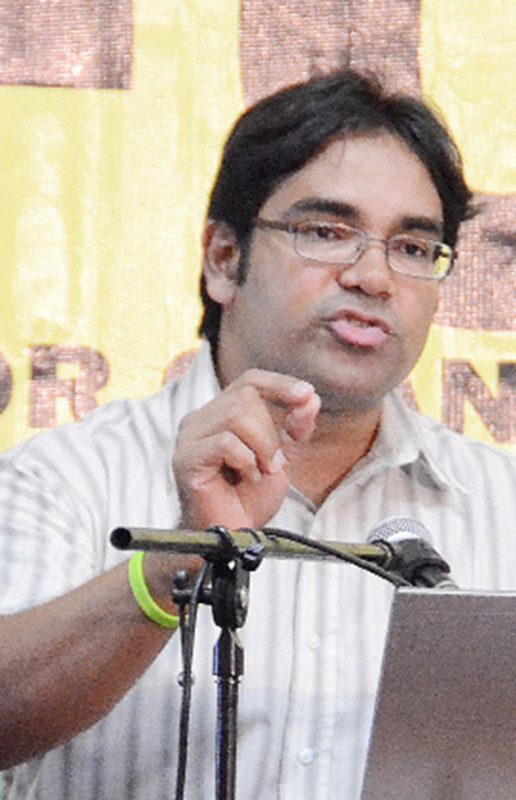Guyana may have lost up to an estimated US$13 million in potential returns on investments due to its sloth in not operationalising its Natural Resource Fund, according to economist Dr Tarron Khemraj.
“Each day the government procrastinates means the country’s loss expands beyond US$13.173 million. By end of 2021, this loss – by choice – would easily exceed US$20 million – the amount of the infamous signing bonus,” Khemraj wrote in his Sunday Stabroek column as he pointed to the paltry interest currently being had on amounts in the Federal Reserve Bank of New York account.
He further argued that the extra income that could be yielded from capital gains and dividends could go a long way towards building a modern highway from Diamond to Mandela Avenue.
After a year in office, the PPP/C government is yet to activate the NRF or to bring amended legislation as analysts say it doesn’t want to be constrained by the annual spending limits that such funds impose. The government has argued that it has not spent a dollar of the oil money but analysts say its actual and projected spending far outstrips what would have been expended from the monies in normal circumstances and is likely to rise even higher.
The World Bank has also told this newspaper that “the early operationalisation of the NRF is essential to address any potential challenges posed by the sudden influx of significant export and fiscal revenues.”
Khemraj made clear that in calculating the estimate based on Guyana’s oil revenues, he did not factor in the nearly US$80 million received from the last sale of oil.
Khemraj used figures for profit oil and royalties at US$309 million and US$35 million, respectively, and said that even with attached fees, the return yielded “could be much higher than the 0.1% that the funds earn in the present account.”
He said that he calculated lost income on the basis on the money being invested in a balanced portfolio of bonds, stocks and real estate funds.
He also noted that there is a misconception by some that investors buy bonds for the current yield, which is very low these days. “The fact is, bonds are bought for their capital gains, not just current yield. The task of an investment manager is to time the markets in order to determine the highest capital gains on bonds, as well as stocks and other asset classes,” he asserted.
“Accounting for fees, I feel that a low baseline return could have been 3% per year. Considering the months of deposit and monthly compounding until August 2021, I calculate that the account would have earned a return of US$7.832 million. However, I feel that a 5% rate of return per annum, after accounting for fees and average risk, on a diversified portfolio is more reasonable. As a matter of fact, I believe it is a more realistic long-term baseline instead of 3%. At the 5% baseline, again assuming monthly compounding, Guyana lost US$13.173 million up to August 2021,” he added.
Pointing out that the existing framework created by the APNU+AFC could be kept and modified as it is a “good starting point” and can work, the economist urged President Irfaan Ali to start the process but warned that too many modifications could lead to a model designed to affect Guyana negatively .
“President Ali should start the Fund’s operation on that basis, in spite of the fact that the Act was introduced by APNU+AFC. The present administration could make modifications, but there is little that they can do to improve on the existing legal framework. Any future modification would most likely take the NRF closer to a Kazakhstan-type model, an outcome that has at least a 50% chance it will not turn out well for Guyana in the long term,” he said.
The model referred to is that of one used by the former Soviet Republic of Kazakhstan, which Khemraj has argued allows for greater discretion in drawing down monies for the national budget. He suggests adopting using the Norwegian model, customised to ensure long-term holistic benefits for this country.
“The discretion is completely within the remit of a powerful President and Prime Minister, and not the technocrats employed to manage the Kazakh fund. On the other hand, the model used by Norway is more rule-based,” he had stated in a previous column.
Noted too was that Guyana’s present legislation does allow for larger upfront withdrawals but he reasoned that the large early deductions will depend on the rate of production, which is likely to continue increasing until 2030. It also depends on the long-term investment return on the Fund, as well as sector-specific growth rates in manufacturing, technology and agriculture.
“Larger upfront withdrawals must be accompanied with greater oversight that curtail the discretion of two or three persons. The withdrawals can still be made in the context of an optimal rule known as the Fiscally Sustainable Amount (FSA), which is already implied by the current legislation. Since the spending is done through the budget process, the existing framework allows for parliamentary debates and oversight,” he said.
